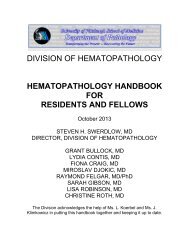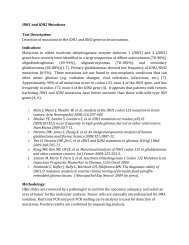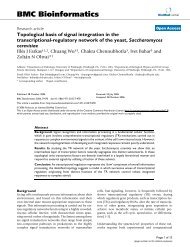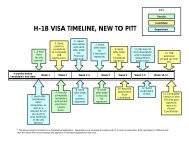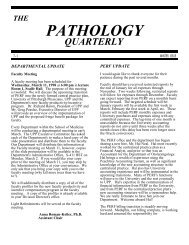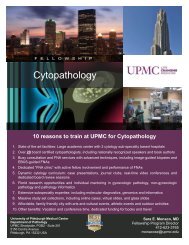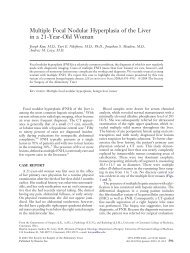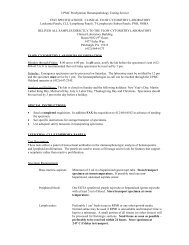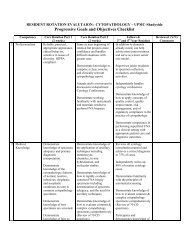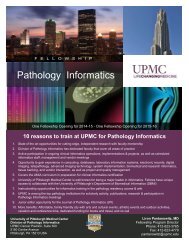molecular pathways and therapeutic targets. Mod Pathol. 2008 May
molecular pathways and therapeutic targets. Mod Pathol. 2008 May
molecular pathways and therapeutic targets. Mod Pathol. 2008 May
You also want an ePaper? Increase the reach of your titles
YUMPU automatically turns print PDFs into web optimized ePapers that Google loves.
Nikiforov Page 4<br />
NIH-PA Author Manuscript NIH-PA Author Manuscript NIH-PA Author Manuscript<br />
carcinomas [47-49]. Tumors harboring PAX8-PPARγ tend to present at a younger age, be<br />
smaller in size, <strong>and</strong> more frequently have vascular invasion. The rearrangement results in<br />
overexpression of the PPARγ protein that can be detected by immunohistochemistry [46,50].<br />
The mechanisms of cell transformation induced by PAX8-PPARγ are not fully understood.<br />
Some evidence has been presented for inhibition of normal PPARγ function via a dominant<br />
negative effect of the PAX8-PPARγ protein on wild-type PPARγ [46,51]. Other studies have<br />
found the activation of known PPAR target genes in tumors harboring PAX8-PPARγ, arguing<br />
against the dominant negative effect [52]. Other possible mechanisms include deregulation of<br />
PAX8 function, known to be critical for thyroid cell differentiation, <strong>and</strong> activation of a set of<br />
genes related to neither wild-type PPARγ nor wild-type PAX8 <strong>pathways</strong> [52,53].<br />
PAX8-PPARγ rearrangements <strong>and</strong> RAS point mutations rarely overlap in the same tumor,<br />
suggesting that follicular carcinomas may develop via at least two distinct <strong>molecular</strong> pathway,<br />
initiated by either PAX8-PPARγ or RAS mutation [48].<br />
RET Point Mutations<br />
Targeted Therapies<br />
Alteration of the RET proto-oncogene plays a causal role in the familial forms of medullary<br />
thyroid carcinoma <strong>and</strong> has also been found in sporadic forms of the disease. In medullary<br />
carcinomas, RET is activated by point mutation, in contrast to its activation by chromosomal<br />
rearrangement in papillary thyroid carcinomas. Germline mutations in the discrete functional<br />
regions of RET are found in almost all patients with familial forms of medullary carcinoma.<br />
In MEN 2A <strong>and</strong> familial medullary carcinoma, mutations are typically located in one of five<br />
cysteine codons within the cysteine-rich extracellular domain [54]. Almost 90% of MEN 2A<br />
mutations affect codon 634, whereas in familial medullary carcinoma they are more evenly<br />
distributed along the cysteine-rich region [55]. These mutations result in unpairing of cysteine<br />
residues in the extracellular domain leading to formation of disulfide bonds between two<br />
mutated receptor molecules <strong>and</strong> lig<strong>and</strong>-independent dimerization <strong>and</strong> constitutive activation<br />
of RET kinase [56]. In MEN 2B, the majority of germline mutations occur in codon 918 in the<br />
intracellular tyrosine kinase domain of RET. This mutation is believed to alters the substrate<br />
specificity of RET kinase, resulting in phosphorylation of unusual intracellular proteins [56].<br />
In sporadic medullary carcinomas, somatic mutations of RET are found in 20-80% of cases<br />
[57,58]. The vast majority of those affect codon 918, although they have also been identified<br />
in few other regions of the gene. Some of these somatic mutations have heterogeneous<br />
distribution within the tumor or are detected only in a subset of metastatic nodules, raising<br />
concerns that they may not be essential for carcinogenesis [58].<br />
Well differentiated papillary <strong>and</strong> follicular carcinomas typically have indolent behavior <strong>and</strong><br />
can be effectively treated by surgery followed by radioiodine therapy. However, tumors that<br />
loose differentiation <strong>and</strong> therefore ability to trap radioiodine or unresectable follicular-cell<br />
derided tumors together with C-cell derived medullary carcinomas do not respond to<br />
radioiodine treatment <strong>and</strong> usually have a much less favorable prognosis. Those tumors are<br />
obvious c<strong>and</strong>idates for alternative <strong>therapeutic</strong> approaches such as <strong>molecular</strong>ly targeted therapy.<br />
Several small-molecule tyrosine kinase inhibitors directed towards RET kinase have been<br />
tested in preclinical <strong>and</strong> clinical studies. ZD6474, an orally active low <strong>molecular</strong> weight<br />
receptor tyrosine kinase inhibitor, is a potent inhibitor of the vascular endothelial growth factor<br />
receptor 2 (VEGFR-2) <strong>and</strong> effectively blocks RET tyrosine kinase [59]. ZD6474 has been<br />
shown to block phosphorylation <strong>and</strong> signaling from RET/PTC3 <strong>and</strong> RET carrying most<br />
common MEN2A <strong>and</strong> MEN2B mutations in vitro, to induce growth arrest of human papillary<br />
<strong>Mod</strong> <strong>Pathol</strong>. Author manuscript; available in PMC 2009 <strong>May</strong> 1.



